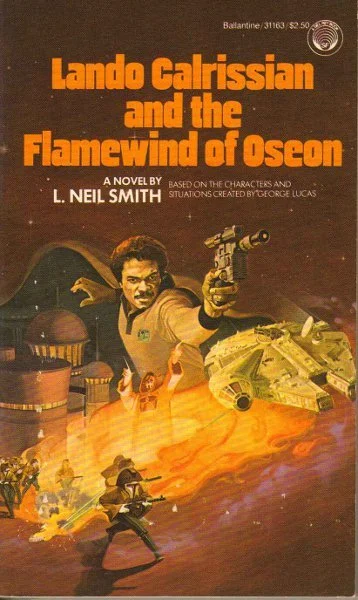Star Wars: Lando Calrissian and the Flamewind of Oseon (Book Review)
Welcome my next read of the Star Wars Expanded Universe/Legends:
Cover image by William Schmidt. Image courtesy of Wookiepedia
It’s been a hot minute since my last review, but I’ve finally gotten time to finish this novel. Some time has passed since their adventures in the Rafa system, and Lando is making a go at being a freighter captain, though he’s finding that it’s hard to make a living that way. With the life crystals sold, he’s back in his usual games of Sabacc and quickly runs into trouble while in the Oseon system during the seasonal Flamewind, a beautiful cosmic radiation phenomenon that is also deadly to space navigation. Let me take a moment to both praise and damn Schmidt’s cover. While beautiful in its 1970’s aesthetic collage, Lando older than in the novel and wielding a variant of Han Solo’s DL-44 heavy blaster pistol—a weapon he doesn’t have. It’s clearly art based on photoshoots from the Original Trilogy and does the job of making any Star Wars fan want to crack the cover to see what treasure lies in the pages within.
“Cycer was dealing the cards when a small spherical droid rolled up beside Lob Doluff and whistled imperatively, then split into a pair of hemispheres.”
Unlike Daley’s Han Solo Adventures, Smith really hits a stride with a mix of world building, character, and plot. Smith leans further into Lando’s life as a gambler and con artist with a conscience. He feels much more distinct as a character than the rough template Daley used for Solo. Published in September 1983, Smith has more material to work with in terms of thematic elements from A New Hope and The Empire Strikes Back. And yet, Smith takes more license to play with the character and explore him and the world in interesting ways. The world building feels unique, with the Flamewind as a sort of beautiful man vs. nature backdrop, and the Millennium Falcon’s design as a supercharged hotrod posing as a junk freighter gives the ship a deeper unexplained history. We also see a bit of Star Wars concepts and lore here as well. The quote above describes what could be an early prototype that becomes BB-8 of the Sequel Trilogy. Vuffi Raa, his penta-tentacled droid companion, displays more skills and character as well. He’s able to break himself apart into component tentacles, though we never quite see that in the universe after that. Smith also blends more science into space fantasy—characters need space suits in space, zero gravity is a thing, and the tech of handling the Falcon through twists and turns shows that Smith spent effort blending elements with plot. We learn more about Sabacc as a game—more interesting SW lore.
“As usual, Lando’s luck, both good and bad, was operating at full blast.”
My favorite element that Smith builds upon is Lando’s luck as a part of him. He’s often (and often) incredibly lucky or incredibly misfortunate. Looking at the character in this light gives a new perspective to The Return of the Jedi. Vader captures Luke to confront the Emperor so that he is distracted from using his Force abilities to guide the fleet at Endor. His luck could also play a factor in Solo and Leia destroying the shield generator at the right time for his team to fly into the Death Star to deliver the killing blow. It’s a stretch, but there’s more color to Lando in Smith’s book that undoubtedly influences the character in later stories—in particular Timothy Zahn’s Thrawn Trilogy later.
“An exasperated expression on his face, Lando asked, “Why do jerks like you always have to go into this thespian routine? If you’re going to kill me, do it with the gun instead of boredom, there’s a good fellow.”
Lando also has a clever wit about him—you’d need such to be a swindler as long as he has. Is this book perfect? No. The constant quips by Lando to Vuffi as ‘old telephone’ or some other tool/instrument was interesting for the first time—but not the twentieth. The secondary plot (a holdover from the Mindharp story) feels unnecessary and unwarranted. There are some hilariously silly new characters like Wayway Fybot, who is clearly a Star Wars equivalent of Sesame Street’s Big Bird, and Bohhuah Mutdah is a pale replica of Herbert’s Baron Harkonnen. Even the secondary villain elicits Lando’s derision at having the villainous plot mansplained to him. Still, I enjoyed this story over all the ones I’ve read in the Legend/Expanded Universe thus far (of which this is only the 6th entry). Smith moves away from the existential feel of Mindharp and into something more character driven. The story is better for it.
May the Force be with you.
